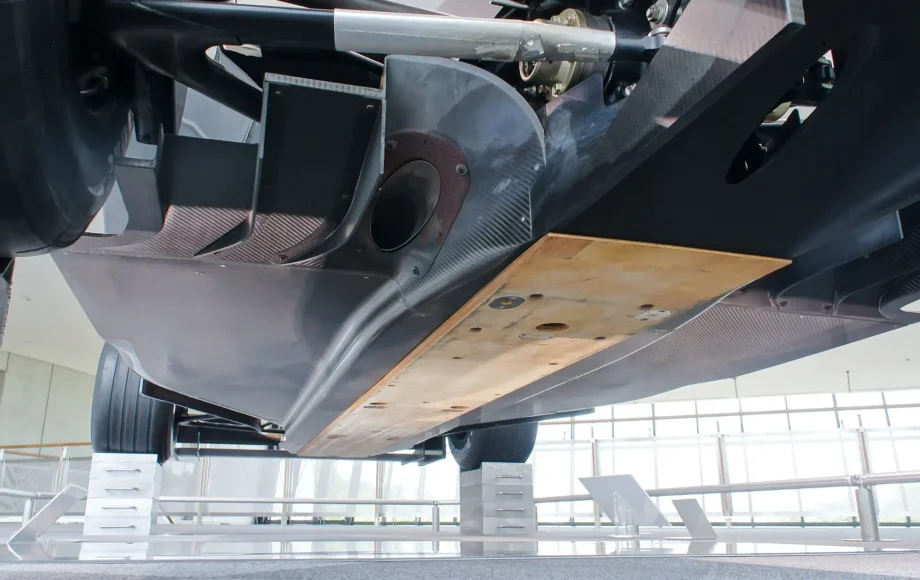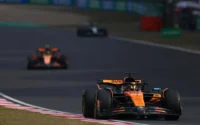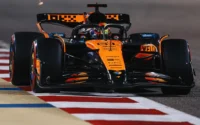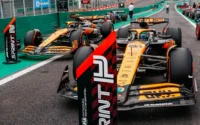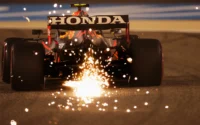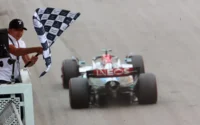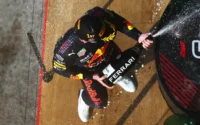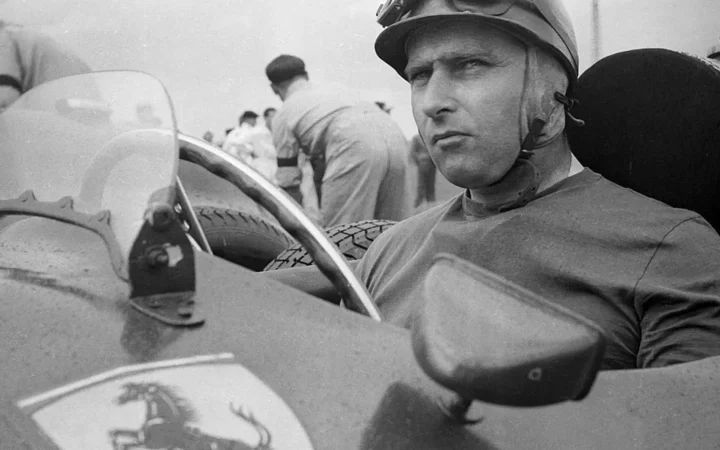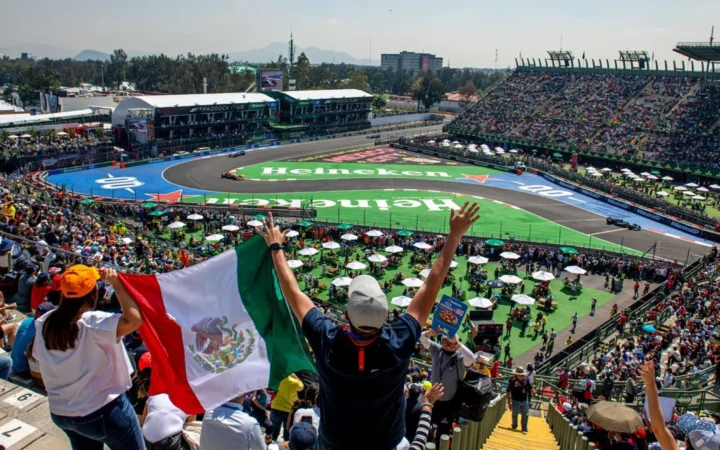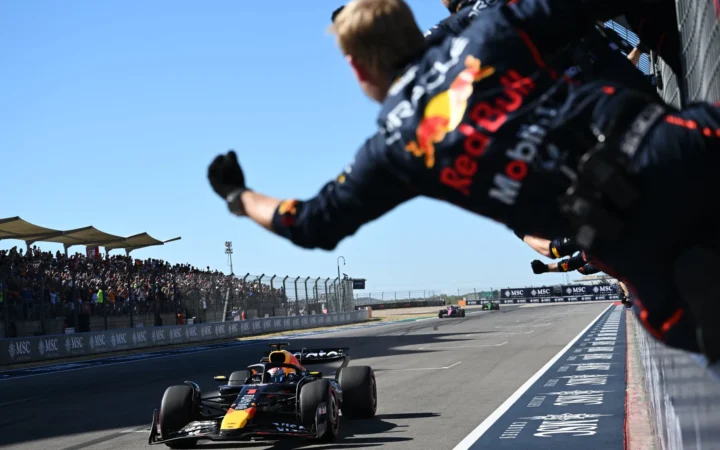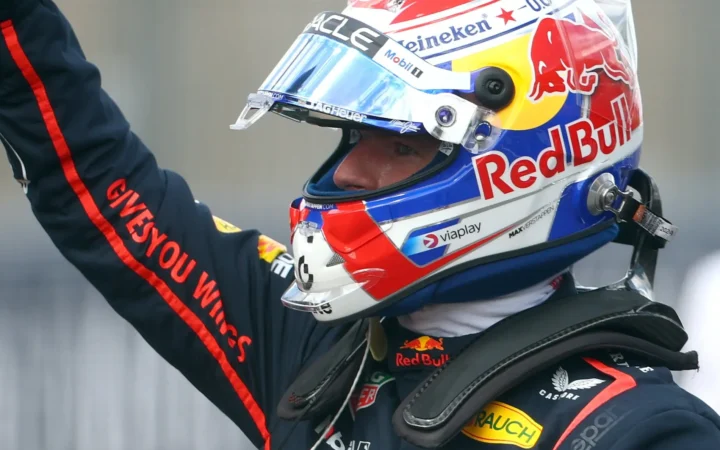Every component of an F1 car is designed for speed, efficiency, and compliance with the sport’s stringent regulations. Among these components is the skid block, a small but crucial part of the car’s floor with a rich history that influences the vehicle’s performance and the sport.
What to know
- Skid blocks were introduced to force a minimum ground clearance to curb excessive speeds that cars were reaching.
- Skid blocks must be made from a bi-composite material, typically including a carbon fibre composite and titanium.
- After each race, the FIA randomly selects cars and measures their wear.
- Drivers can be disqualified for excessive wear on the skid block.
- 2025 season: Lewis Hamilton‘s Ferrari skid block measured 8.6mm on the left-hand side and centreline and 8.5mm on the right-hand side—below the mandated 9mm minimum specified under Article 3.5.9 of the Technical Regulations at the 2025 Chinese GP. He was disqualified. Nico Hulkenberg was also disqualified at the 2025 Bahrain Grand Prix for a similar infringement.
In this latest F1 guide, we examine the skid block’s design and its changes over the seasons since its introduction. We also examine the materials it is made of, its aerodynamic properties, the regulations that determine how it is used, and its role in race strategy and performance.
Evolution and purpose of the skid block
Skid blocks, also known as ‘planks,’ are elements attached to the bottom of an F1 car. Their primary purpose has evolved significantly over the years. In the early days of their introduction, skid blocks were meant to limit the amount of downforce that cars could generate. By forcing a minimum ground clearance, the governing bodies aimed to curb the excessive speeds cars reached, especially through corners, thereby improving safety.
Over time, skid blocks have also come to play a key role in preserving the integrity of the vehicle. They prevent the car’s floor from wearing out due to constant scraping against the track surface, which can be caused by bottoming out due to high downforce or running over kerbs. They also serve as a crucial element in the compliance of cars with regulations, acting as a reference point for race stewards to measure the legality of the car’s ride height after a race or qualifying.
What is an F1 skid block made of?
The material used for skid blocks is a subject of particular interest in F1. Initially, they were made of wood, specifically a type of hardwood called Jabroc. However, as technology progressed, F1 teams began experimenting with more advanced materials to optimise the durability and performance of the skid block.
Today, the FIA (Fédération Internationale de l’Automobile) mandates that skid blocks must be made from a bi-composite material, typically including a carbon fibre composite surface for strength and titanium for its wear-resistant properties. The combination of these materials ensures the skid block can withstand the incredible stresses and temperatures it’s subjected to during a race while also being light enough not to affect the car’s performance significantly.
| Material | Characteristics | Benefits |
|---|---|---|
| Carbon Fiber | Lightweight, high tensile strength | Enhanced structural integrity |
| Titanium Alloys | Durable, heat-resistant | Improved heat dissipation |
| Advanced Polymers | Flexible, impact-absorbing properties | Increased shock resistance |
Aerodynamics and skid blocks
While skid blocks are not primarily aerodynamic devices, their placement on the car can influence the aerodynamics. Teams meticulously shape and position the blocks to minimise any potential aerodynamic disruption. The precise engineering ensures that air flowing under the car does not become turbulent due to the blocks, which could lead to a loss in downforce and, subsequently, a loss in speed.
When a car ‘sparks’ as it skims the track surface, it is often the skid blocks making contact. While this is visually spectacular, teams work hard to ensure that such sparking is minimal, as every contact with the track is a form of aerodynamic disturbance and a drag on performance.
Regulations and compliance
The FIA closely regulates the dimensions, placement, and wear of the skid blocks. They must meet strict specifications in terms of size and must be fitted to the car in designated locations. After each race, the FIA will select cars randomly or based on race data, and the skid blocks are one of the measured components.
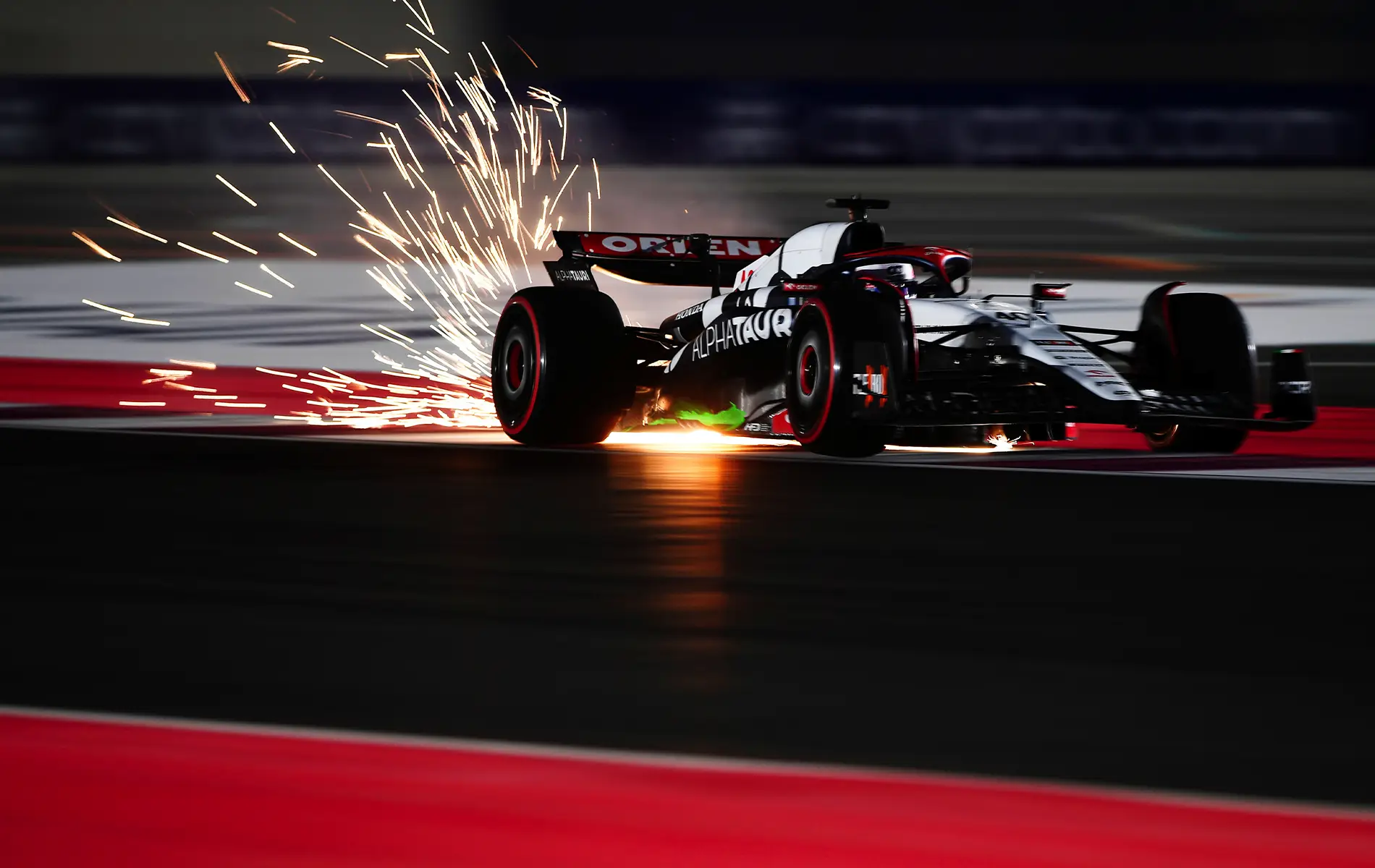
If the FIA find the skid block has worn down past a specific limit, the car can be disqualified as it suggests the car has been running lower than the permitted ride height, potentially gaining an unfair aerodynamic advantage. A recent example was when Lewis Hamilton and Charles Leclerc were disqualified from the 2023 United States GP.
This tight regulation ensures that all teams adhere to the principle of fair play and that cars do not gain excessive speed through dangerous levels of downforce. It is a delicate balance between allowing teams to explore the limits of engineering and ensuring the safety of F1 drivers and the spirit of competition.
Who was the first to be disqualified for illegal skid block wear?
The first instance of a driver being disqualified for contravening the skid block wear regulations occurred at the 1994 Belgian Grand Prix.
Michael Schumacher, who had initially taken the chequered flag, was later stripped of his win. The post-race technical inspection revealed that the skid block on his Benetton car had worn down beyond the legal limit, which was a clear violation of the newly implemented rules regarding plank wear.
Why were Hamilton and Leclerc disqualified from the 2023 United States GP?
In a dramatic turn of events at the 2023 United States Grand Prix in Austin, two of Formula 1’s leading drivers, Lewis Hamilton of Mercedes and Charles Leclerc from Ferrari, faced disqualification, stripping them of their second and sixth-place finishes, respectively. This decision came after the race’s conclusion when a routine but random technical inspection was conducted on four of the participating cars, as per the FIA’s standard operating procedures.
During the meticulous post-race examination, the technical stewards discovered that the skid blocks affixed to the underbellies of the Mercedes and Ferrari cars showed signs of excessive wear beyond what is permissible under the current Formula 1 Technical Regulations.
Upon further inspection, it became clear to the FIA officials that the skid blocks on Hamilton‘s and Leclerc‘s cars did not meet these stringent requirements. The wear exceeded the maximum allowable limit, implying that their cars potentially benefited from an aerodynamic edge by running closer to the track surface than their competitors.
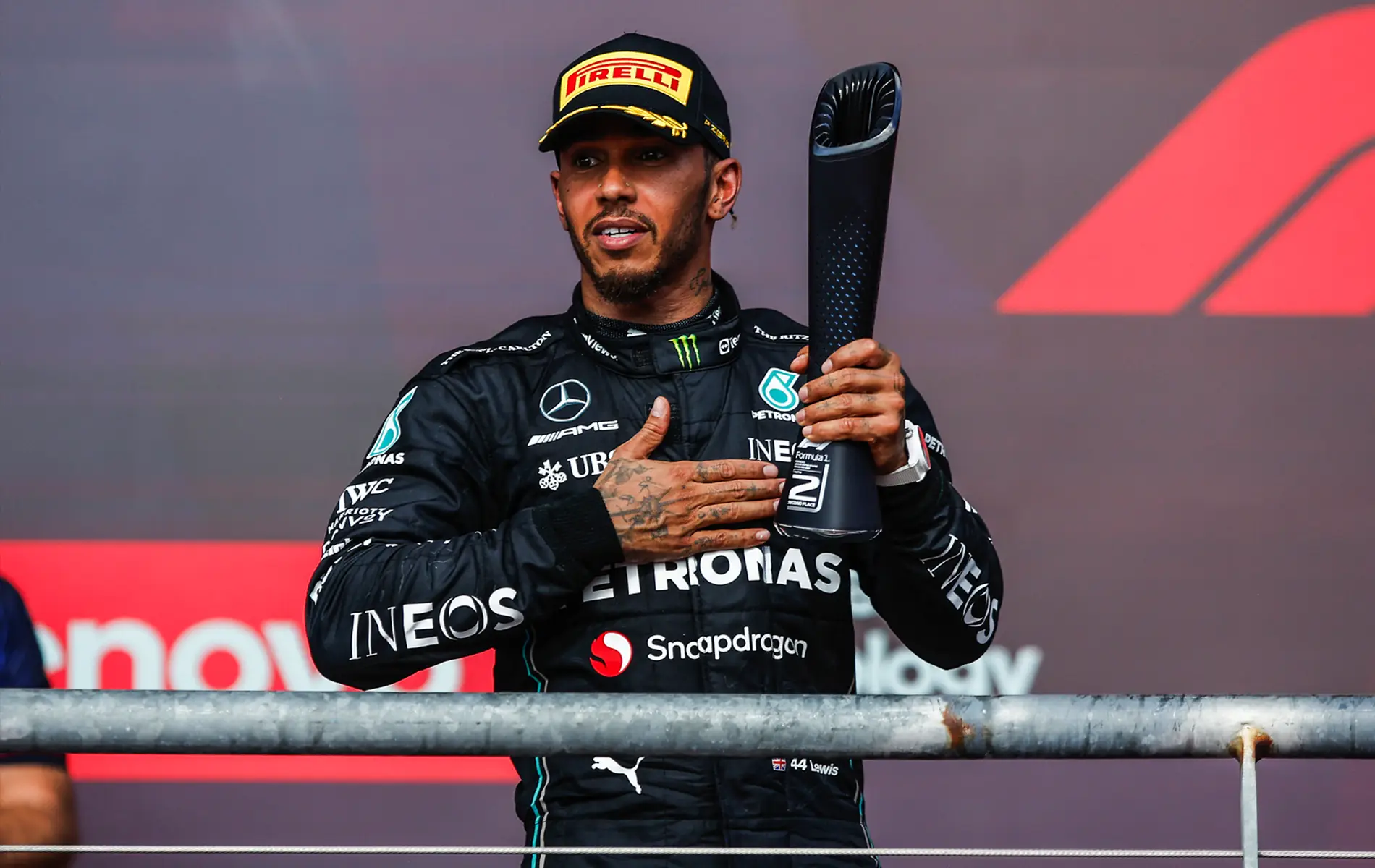
The disqualification of Hamilton and Leclerc had immediate and significant implications for the drivers’ standings, as well as for the constructor’s championship. Points scored during a Grand Prix are crucial, and losing out on them can drastically alter the momentum of a team or driver over the season. The incident also highlighted the intense scrutiny that Formula 1 cars are subject to in terms of regulatory compliance, reflecting the sport’s commitment to fairness and safety.
The fallout from these disqualifications would have carried over to the following races, with Mercedes and Ferrari compelled to reassess their cars’ setups and possibly their approach to skid block durability. It’s a stark reminder that teams must walk between maximising performance and adhering to the sport’s rigorous technical standards.
Why was Lewis Hamilton disqualified from the 2025 Chinese Grant Prix?
Ferrari’s 2025 Chinese Grand Prix ended in disaster after both Lewis Hamilton and Charles Leclerc were disqualified from the final results due to technical regulation breaches. Post-race inspections revealed that Hamilton’s rear skid block was below the minimum thickness required, while Leclerc’s car failed to meet the minimum weight limit.
According to the FIA, the skid block on Hamilton’s car measured 8.6mm on the left-hand side and centreline and 8.5mm on the right-hand side—below the mandated 9mm minimum specified under Article 3.5.9 of the Technical Regulations. Leclerc, who had initially finished fifth, was also disqualified after his Ferrari was found underweight following post-race checks.
Adding to the drama, the Alpine of Pierre Gasly was also disqualified from P11 for the same weight breach as Leclerc, capping a tough start to the season for the Enstone squad, which remained the only team yet to score points in the 2025 F1 Season. The shake-up promoted Esteban Ocon, Kimi Antonelli, Alex Albon, and Ollie Bearman up two positions each. At the same time, Lance Stroll and Carlos Sainz were elevated into the top 10 to collect the final points.
Full Race Weekend Report
Why was Nico Hulkenberg disqualified from the 2025 Bahrain Grant Prix?
Nico Hulkenberg was disqualified from the 2025 Bahrain Grand Prix after his Kick Sauber was found to be in breach of the Technical Regulations due to excessive plank wear. The decision, confirmed after post-race scrutineering on the Sunday night, stripped the German of his 13th-place finish in what had been a quietly solid performance during the 57-lap race in the desert.
Hulkenberg had gained three positions over the course of the race, managing tyre wear well and staying out of trouble in a race that saw plenty of midfield shuffling. However, routine checks conducted by FIA Technical Delegate Jo Bauer revealed that the rearmost skid block on his car had worn below the legal limit. Measurements taken at three specific points showed readings of 8.4mm on the left side, 8.5mm along the car’s centerline, and 8.4mm on the right—each falling short of the minimum 9mm thickness required by Article 3.5.9 e) of the 2025 F1 Technical Regulations.
The regulations are crystal clear: while the plank assembly must begin at a uniform thickness of 10mm ± 0.2mm when new, up to 1mm of wear is tolerated through the race. Exceeding that allowance, as in Hulkenberg’s case, resulted in automatic non-compliance, which the stewards acted upon swiftly.
This was the second high-profile disqualification for excessive plank wear in the 2025 season, following Lewis Hamilton’s similar fate at the Chinese Grand Prix. The rule, designed to ensure teams do not run their cars too low to the ground for aerodynamic advantage, had caught out multiple teams already in a season where the margins were proving razor-thin.
The decision bumped his teammate Gabriel Bortoleto up from 19th to 18th in the final classification, though it provided little comfort for the Sauber camp, who were left with no points in the race’s final standings.
Full Race Weekend Report
What are the skid block rules?
The F1 technical rulebook specifies the exact dimensions and tolerances for the skid block. According to Article 3.5.9 e) of the 2023 F1 technical regulations, the plank must start at a uniform thickness of 10 millimetres, with a margin of error of plus or minus 0.2 millimetres when it is brand new. This precise measurement ensures that, before the wear from racing conditions, all teams start with skid blocks that are identical in thickness.
Throughout a race, as the car skims over the racetrack’s surface, the plank inevitably wears down. The regulations accommodate this wear, permitting the plank to erode to a minimum thickness of 9 millimetres. Any wear beyond this point is considered a breach of the technical regulations. It is crucial to note that this wear is measured at the periphery of designated holes in the plank. These holes are strategically placed and are used by the race stewards to insert measuring devices that determine whether the wear is within the legal limits.
This specific minimum thickness prevents teams from setting their cars too low, a practice that could potentially offer significant performance gains by exploiting ground effect aerodynamics. If a car’s skid block is below the 9-millimetre threshold, the car may have been running lower than competitors.
How is the plank’s thickness measured?
This measurement is conducted by examining the plank through six precisely drilled holes: four with a diameter of 50mm and two larger holes at the front with a diameter of 80mm. These holes penetrate 10mm deep into the plank and titanium plates.
If, upon inspection, officials detect that the wear exceeds 1mm at any point within these holes, it signifies that the plank or titanium plate has worn down past the acceptable limit. Such a finding would result in the driver’s automatic disqualification as it indicates a breach of the FIA’s technical regulations.
Impact on performance and race strategy
Skid blocks play a subtle role in performance and race strategy. Although their primary purpose is not to enhance performance, how they are engineered and maintained can significantly affect them. If a skid block wears down too quickly, it can force a team to raise the ride height of their car, adversely affecting aerodynamics and tyre performance. Therefore, teams will strategise using skid blocks, considering track surfaces and ride height settings for optimum performance.
In qualifying, where cars are run as low as possible for maximum speed, skid blocks are critical. Teams must balance running low enough to be fast but not so low as to cause excessive wear to the skid blocks, which could lead to penalties.
More on F1 Qualifying
Wear and maintenance
The wear of skid blocks is a constant concern for F1 teams. They must be frequently inspected and replaced to ensure that they are within regulatory limits and to prevent damage to the car’s floor. The wear can be affected by factors such as the circuit layout, driving style, and setup choices, with more aggressive settings leading to increased wear.
Teams must monitor the wear rates closely during practice sessions and predict their degradation during races to avoid falling foul of regulations or compromising the car’s performance. This was seen as one of the contributing factors to Hamilton and Leclerc falling foul of the rules. The 2023 US Grand Prix was a Sprint weekend. Cars were subject to Parc Fermé rules from Friday evening, so the skid blocks could not be checked or replaced, and car adjustments could not be made without penalties.
The future of skid blocks in F1
As F1 continues to evolve, so does the technology around skid blocks. Teams continually research new materials and designs that could offer even slight performance gains or durability improvements. The future may see the integration of sensors within the skid blocks to provide real-time data on wear and performance impacts, enabling more precise management of the car’s setup and strategy.
Additionally, there is a continuous push for more sustainable materials in line with the sport’s environmental objectives. Biodegradable or recycled materials that can withstand the rigours of F1 could be the next step in skid block development.
Frequently asked questions
What is a skid block in Formula 1 racing?
A skid block is a component attached to the bottom of an F1 car. It ensures a mandated ground clearance is maintained, protecting the vehicle’s floor from excessive wear and sparks when the car contacts the track surface.
How does the skid block affect the aerodynamics of an F1 car?
While skid blocks are not aerodynamic devices, their presence can affect airflow under the car. They are engineered to be as non-intrusive as possible to minimize turbulent air and aerodynamic drag.
What materials are used to make skid blocks in Formula 1 cars?
Skid blocks are made from a bi-composite material, including carbon fibre for strength and titanium for wear resistance, to withstand the high demands of F1 racing.
Why do F1 cars spark?
Why do F1 cars spark? The striking showers of sparks that trail Formula 1 cars during a race result from the titanium skid plates fixed to the car’s underside. When the car ‘bottoms out’ on high-speed straights or fast corners, when the downforce is at its greatest, the titanium scrapes against the track surface and creates a vivid display of sparks. It’s a great spectacle for F1 fans but also indicates the intense physical forces in Formula 1 racing.
Formula One History Recommends
Conclusion
The skid block may seem like a minor detail in the complex engineering of an F1 car. Yet, it encapsulates the spirit of the sport: the relentless pursuit of performance within the tight confines of regulation. It balances the need for safety with the competitive drive that defines Formula 1. As materials advance and regulations evolve, the skid block will continue to play a critical role in the sport’s development, reflecting its commitment to innovation and competition.
For more F1 Terms, check out our F1 Glossary, covering everything from DRS and G-force to oversteer, slipstreaming, tyre warmers, and turbulence. This guide offers clear explanations of the most frequently used F1 terms. You’ll be speaking the language of Formula 1 like a seasoned fan in no time.
Seen in:

